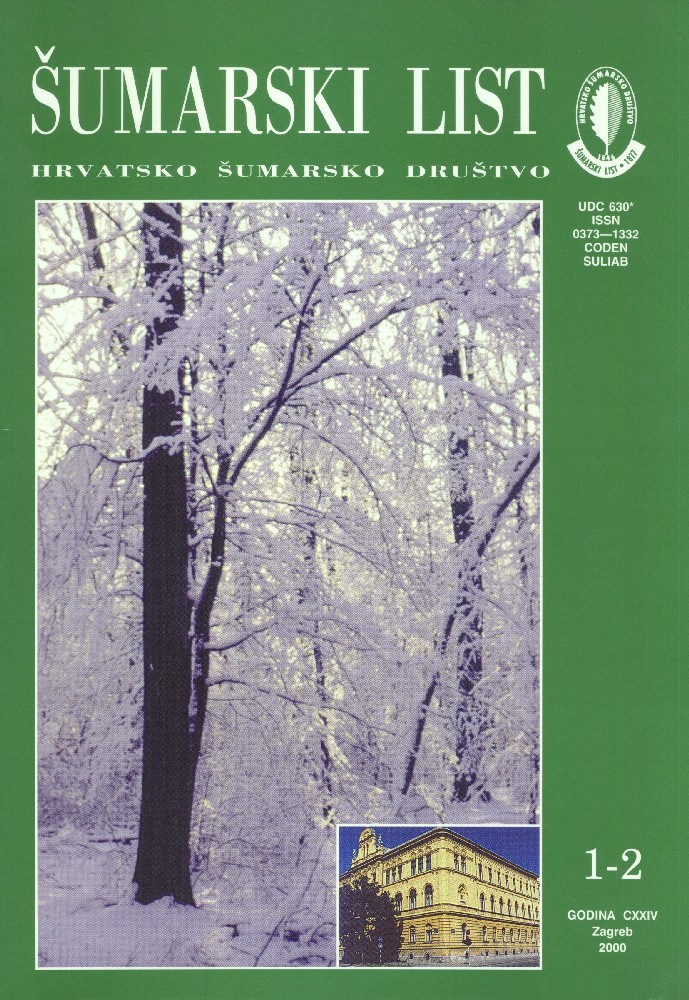
broj: 1-2/2000
pdf (35,1 MB) |
|
||||||||||||||
| PREGLEDNI ČLANCI | ||
| Martinić, I. | UDK 630* 377 + 461 | |
| Environmentally Friendly Use of Machinery in Forestry – a Soap Bubble or Near Future pdf HR EN | 3 | |
| Starčević, M. | UDK 630* 116 + 469 | |
| The Effects of Hydro-Melioration on Forest Vegetation of Varoški Lug pdf HR EN | 15 | |
| Domac, J. | UDK 630* 161 | |
| Face Project: Monitoring of Free-Air CO2 Enrichment Impact in Closed Canopy Deciduius Forest Projekt FACE: Die Beobachtung vom Einfluß der Luftbereicherung mit CO2 in dichter Beschirmung von Laubwäldern pdf HR EN | 27 | |
| Summary: A free-air CO2 exposure (FACE) facility, comprising four 25-m exposure rings and two ambient plots, was constructed in a deciduius forest on the Oak Ridge National Environmental Research Park with the objective to understand how the eastern deciduous forest will be affected by CO2 enrichment of the atmosphere, and what the feedback are from the forest to the atmosphere. This goal will be approached by measuring the integrated responce of an intact forest ecosystem, with a focus on stand-level mechanisms.The study site is a sweetgum (Liquidambar styracifla) monoculture planted in 1988. This 15-m tall stand has a closed canopy with a leaf area index of 4-5, a basal area of 34 m2/ha, and it is in a linear growth phase. It offers the opportunity for rigorous tests of hypotheses that address the essential features of a forest stand and how they could influence the responces to CO2. These features include: • the closed canopy, which constrains growth responses; • full occupancy of the soil by the root system, which constrains the nutrient cycle; • the larger scale of the trees compared to saplings in open-top chambers, which changes the functional relationships of carbon cycling; • and the longer time scale that can be addressed, permitting studies of forest regeneration and soil carbon changes. Different tasks are organized around an interconnected set of hypotheses. The objectives of these tasks are: • characterize aboveground tree growth and leaf area in relation to CO2 concentration and interannual variation in other environmental factors; • determine the relationships between stand dynamics, photosynthesis, respiration, and tissue chemistry; • establish the importance of stomatal conductance, boundary layer conductance, and canopy conductance as factors regulating whole-plant transpiration response to elevated CO2; • measure stem respiration response in sweetgum to CO2 and partition observed responses into growth and maintenance respiration; • quantify fine root density and turnover; • determine the trajectory of response to CO2 in leaf litter chemistry, and begin long-term measurement of litter decomposition; • quantify the critical components of the nitrogen cycle and their response to CO2 enrichment; • identify sources and dynamics of soil organic matter and their response to CO2 enrichment; • construct an intra-annual carbon budget for the stands to determine the impact of elevated CO2 on net ecosystem production; • use a mechanistic, process-based soil-plant ecosystem model to develop and refine hypotheses of ecosystem response to elevated CO2. The CO2 enrichment treatment (560 ppm) began in April, 1998, after a full year of pre-treatment site characterization and tree growth monitoring. Although significant results has been already achieved, all described responses must be considered preliminary because the trees had been growing in ambient CO2 for 10 years prior to the start of fumigation and their responses to the sudden increase in CO2 are likely to be different from what would occur had they always been in high CO2. This is why there are no results published so far. Data presented in paper were collected and photos taken during authors visit ORNL in September 1999 as a participant of IEA Bioenergy International Workshop. Additional information were collected from Dr Richard Norby and Dr Gregg Marland (Oak Ridge National Laboratory). For global changes like CO2 increase and associate climate changes would affect Croatia as well as every other part of the world, it could be interesting to learn about current trends and recent experiments on that field. Key words: CO2; FACE facility; sweetgum stand | ||
| Sabadi, R. | UDK 630* 791 + 799 | |
| Profile of Switzerland’s Forestry and Timber Industries in 1995 pdf HR EN | 33 | |
| Zelić, J. | UDK 630* 181.1 (Taxus baccata L.) | |
| Yew (Taxus baccata L.), a rare species in the mountains of Požega pdf HR EN | 41 | |
| STRUČNI ČLANCI | ||
| Potočić, N., Seletković, I. | UDK 630* 48 (Abies alba. Quercus robur, Fagus sylvatica) | |
| Croatia Forests Damage Status 1998 pdf HR EN | 51 | |
| Tuškan, S. | UDK 630* 242 | |
| The Role of Structure on Tending Stands with Thinning in Forest of Pedunculate Oak and Common Hornbeam (Querco roboris - Carpinetum illyricum, Anić) pdf HR EN | 57 | |


